“Everything will be different with the next dog”
You often hear this resolution. However, people tend to forget how many things actually go well and what the handler has learned from their dog. My first agility dog was an Elo. This mix of Old English Sheepdog, Eurasier and Chow Chow is certainly not one of the predestined agility breeds. If it’s too warm, the Elo likes to wait under the A-frame in the shade. In general, he doesn’t like to be rushed and is more on the calm side. But it was precisely through these character traits that I was able to learn an incredible amount about the balance between building drive and impulse control, as well as the learning behavior of the dog, even if a certain amount of frustration accompanied the agility career.
Was everything different with the next dog? Of course not! Because the things that worked well with the Elo didn’t work in exactly the same way with the Border Collie. As dog trainers and handlers, we have to adapt to each new breed and each new dog individually. There is no one-size-fits-all solution and we have to find a balance between building up drive, controlling impulses and encouraging thinking skills.
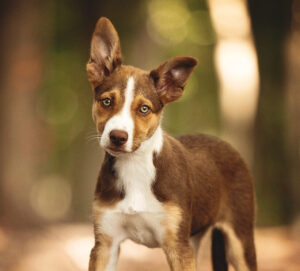
It is much more important to reflect on your own experiences and question why a training approach has or has not worked with a specific type of dog. We must not be afraid to deviate from the instructions and think outside the box.
Time and again I see agility handlers wanting to do everything better with their new dog than with the previous one. Absolutely understandable, because who wants to repeat the mistakes they made when training their dog?
If we want to make “everything better”, we run the risk of focusing too much on the areas that were not perfect in the previous dog. If we had a dog that didn’t want to play, we now want to pay special attention to the building drive. Or the new dog should have very good impulse control if the previous dog had a start line problem.
However, this extreme focus on individual areas can be problematic. That’s why I try to use 3 elements in my training and keep them in balance.
3 pillars of training
As a prerequisite for later training, I already teach 3 basic pillars at puppy age: Building drive, impulse control and thinking skills. The training of older dogs can also be divided into these elements. An agility dog should be trained in each of these areas in order to be successful on the course. It is important to maintain a balance between the 3 elements. But what exactly is meant with these terms?
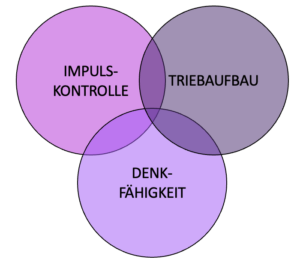
Building drive
Building drive is all about reinforcing the dog’s innate drives. The puppy’s instinct to play is what we refer to. This can include tug or chase games with a toy. We can just as easily build up a drive for a “dead prey”, i.e. a static (laid out) toy. For me, the drive for food also falls into this area. Not every dog likes to work for food, but this can also be learned. When training this, one should also work on a static food reward. This can be a food machine, for example, but also a treat pocket or food ball.
Who need to build drive?
Exercises to build up drive are useful for all types of dog. A dog that already has a lot of drive for toys does not automatically have to have a lot of drive for a static food reward. It may well be that this has to be learned first. In the same way, some food-driven dogs who love the food machine don’t necessarily value a toy reward. However, as I want to be able to reward flexibly in my training, my dog should perceive different rewards as rewarding and not just accept them. Ultimately, it is up to us to convey a reward to the dog as rewarding.
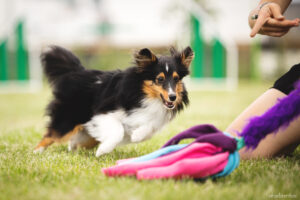
Impulse control
Impulse control is the ability to control oneself. A dog that sits obediently while the food bowl is placed in front of it controls its impulses. He would probably much rather pounce on the food, but he has learned that it is more worthwhile for him to wait. In agility, impulse control is required both at the start hurdle and in the contact zones. After all, most dogs would prefer to start more quickly or not wait until the seesaw touches the ground. Running contacts are an exception, where impulse control of the dog and the human is not necessary. Certainly another reason why many handlers and dogs like it.
But our dog also needs a certain degree of impulse control to enter a competition at all. Because in Germany at least, the companion dog test is required before being allowed to compete.
Who needs impulse control?
Again, the answer is that impulse control exercises are important for all dogs. Very active dogs with a strong play or hunting instinct will certainly need more practice before they reach the same level of impulse control as calmer dogs. But representatives of the calm type also benefit from impulse control exercises. These dogs in particular are often unsure when an action is expected or desired of them. Through targeted exercises for impulse control and, in particular, targeted release of the control positions, we can make it clear to these dogs when we want them to act.
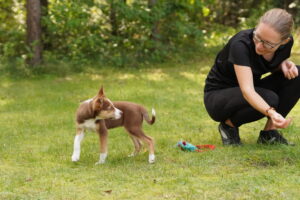
Thinking skills
The third pillar, the ability to think, I understand as the cooperation of the dog in figuring out exercises, as well as reacting to cues. The dog should understand that our commands have a meaning for him. Nevertheless, they should also know when it is appropriate to introduce their own ideas into the training session. This is the case with classic shaping and I am introducing a separate command for this. This teaches the dog when it is appropriate to think more freely and try things out. This is different from situations where he should only perform what he has learned on cue, without becoming creative himself.
Who needs thinking skills?
The answer here is not quite so simple, as it depends on the handler’s preference. A handler who is athletic himself and can and wants to run a lot certainly does not have to train his dog as well as a handler who cannot help his dog as well with body language. In general, exercises to promote thinking are useful for anyone who wants to train their dog as well as possible.
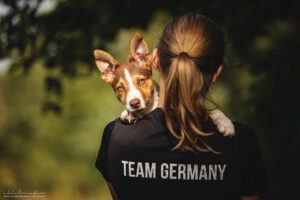
Keeping the balance
The key to good basic training is to maintain a balance between building drive, impulse control and thinking skills. Because if an area is missing, it is noticeable in the performance. All three elements influence each other and also overlap in some exercises. Let’s take a look at a simple stay exercise. Every wait in a control position such as sit, down or stand requires elements of all three areas:
– The ability to think ensures that the dog assumes the position in the first place
– Impulse control ensures that the dog waits
– The drive for the object/action of desire increases (food, toy, running, …)
The more drive a dog brings with it or develops through drive building, the more he must also learn impulse control, as he will find the stimuli to which he is exposed more and more attractive due to the build-up of drive and must therefore control himself all the more. Better thinking skills will increase your dog’s confidence and commitment to training. It will be easier for him to make correct decisions and to show impulse control. Better impulse control then allows more drive to build up and the drive itself increases when released.
If, on the other hand, only one of the areas is promoted, an imbalance can occur.
Building drive dominates
A dog that is only encouraged in the area of building drive, but does not learn to control its impulses and pay attention to commands or work together with the handler, will quickly become overwhelmed by certain situations. This dog will find it harder to focus on the handler and will be easily distracted by other dogs or external stimuli. He will also find it difficult to wait and think through a situation.
Impulse control dominates
If impulse control is overly encouraged, the dog will lean towards passivity. A trait that is perhaps desirable for some pet dogs who should spend all day on the couch, but which we don’t necessarily want in sport dogs. These dogs often don’t dare to do anything without asking. They work less independently and are rather insecure. They must be take to every obstacle on the course and given instructions for every small step during training. This is often at the expense of motivation and speed in agility.
Thinking skills dominate
If a lot of thinking exercises are done, but little on impulse control, this can lead to a dog that thinks too much and therefore no longer runs. He has too many options in his head and knows many commands, but becomes too “stuck in his head” as a result and prefers to run more slowly so that no mistakes are made. This dog will also find it harder to come out of his shell and get up to speed.
The mix is important
It is therefore crucial to have a balanced mix of exercises to build up drive, exercises to work on impulse control and exercises to develop thinking skills. For puppies and young dogs in particular, there are many great opportunities to teach them in these areas and prepare them for the demands of later training without any physically demanding exercises. Those who lay good foundations here will have a much easier time later when it comes to more complex training tasks such as teaching contacts or differentiating between obstacles.
In my online course “Basics for Sport Dogs”, the 3 topics are taught together with many other skills. The course provides the perfect foundation for all dogs that are later to be trained in various sports. You can find more information here:
